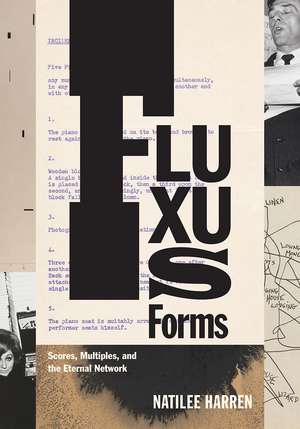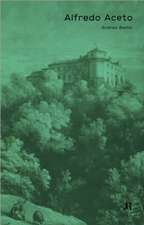Fluxus Forms – Scores, Multiples, and the Eternal Network
Autor Natilee Harrenen Limba Engleză Hardback – 29 iun 2020
While today the Fluxus collective is recognized for its radical neo-avant-garde works of performance, publishing, and relational art and its experimental, interdisciplinary approach, it was not taken seriously in its own time. With Fluxus Forms, Natilee Harren captures the magnetic energy of Fluxus activities and collaborations that emerged at the intersections of art, music, performance, and literature. The book offers insight into the nature of art in the 1960s as it traces the international development of the collective’s unique intermedia works—including event scores and Fluxbox multiples—that irreversibly expanded the boundaries of contemporary art.
Preț: 370.90 lei
Nou
Puncte Express: 556
Preț estimativ în valută:
70.97€ • 74.95$ • 59.06£
70.97€ • 74.95$ • 59.06£
Carte disponibilă
Livrare economică 23 decembrie 24 - 06 ianuarie 25
Livrare express 06-12 decembrie pentru 53.09 lei
Preluare comenzi: 021 569.72.76
Specificații
ISBN-13: 9780226354927
ISBN-10: 022635492X
Pagini: 304
Ilustrații: 12 color plates, 70 halftones
Dimensiuni: 185 x 265 x 22 mm
Greutate: 0.86 kg
Ediția:First Edition
Editura: University of Chicago Press
ISBN-10: 022635492X
Pagini: 304
Ilustrații: 12 color plates, 70 halftones
Dimensiuni: 185 x 265 x 22 mm
Greutate: 0.86 kg
Ediția:First Edition
Editura: University of Chicago Press
Notă biografică
Natilee Harren is assistant professor of modern and contemporary art history at the University of Houston and author of Karl Haendel: Knight’s Heritage.
Cuprins
Prelude: The Artwork in Flux
1: Diagramming Form, from Graphic Notation to the Fluxus Event Score
2: Of Drips, Diagrams, and Immanent Form: Fluxus in the Wake of Abstract Expressionist Painting
3: George Brecht and the Notational Object
4: George Maciunas, Fluxboxes, and the Transitional Commodity
5: Objects Without Object: Robert Filliou and the Unworking of Fluxus
Coda: The Fluxus Virtual, Actually
1: Diagramming Form, from Graphic Notation to the Fluxus Event Score
2: Of Drips, Diagrams, and Immanent Form: Fluxus in the Wake of Abstract Expressionist Painting
3: George Brecht and the Notational Object
4: George Maciunas, Fluxboxes, and the Transitional Commodity
5: Objects Without Object: Robert Filliou and the Unworking of Fluxus
Coda: The Fluxus Virtual, Actually
Acknowledgments
Notes
Index
Notes
Index
Recenzii
"Fluxus Forms is an important addition to Fluxus art scholarship because it centralizes the object, detailing how collaborative authorship and multiple receivers yield(ed) myriad contingent and conditional forms. . . . This history, broadly speaking, contextualizes Fluxus in the 1960s postwar, consumer culture when postmodernism eclipsed modernism. The legacy further unfolds in Harren's insightful coda, in which she positions Fluxus artistic practice of making distinct, mutable forms as living on in virtual spaces active in contemporary art. . . . Summing Up: Recommended."
"Richly researched and academically grounded, Harren fluidly weaves together the stories of artists and events key to the evolution of Fluxus... an outstanding addition to the literature on Fluxus that offers new context and fresh insight on the foundations of art performance and object-based practices."
"Harren establishes Fluxus’s legibility by tracing its roots back to the 'New York school' music of Cage, Earle Brown, Morton Feldman, and Christian Wolff. The book’s lengthy, important first chapter draws extensively from musicology to unpack the profound implications of graphic composition. . . . Fluxus Forms thus considerably enhances Fluxus’s legibility. But what of Fluxus’s relevance? In a concluding coda, Harren makes her case for the movement’s enduring influence while also preemptively fending off a possible misinterpretation of her argument that would conflate Fluxus’s diagrammatic relations with social media’s digital connectivity. In opposition to scholars such as Craig Saper and Owen Smith who have hailed Fluxus as an anticipation of internet art, Harren insists that Fluxus’s publications and performances refuse the mediation of pixelated screens. . . . Fluxus Forms has reshuffled the deck. With a few additional cards, it might even change the game."
"Grade this book A+."
"Natilee Harren concludes that 'the Fluxus Artists' most important contribution to the history of contemporary art lies in their adaptation of the score format as a model for all kinds of artistic production beyond musical performance.' It is this essentially musicological aspect of Harren's book that sets it apart from any other analysis of the essence of Fluxus in recent years."
"[An] excellent new book."
“With this deeply researched and engagingly written book, Harren gracefully erases boundaries between art history and musicology. In the discussion of George Brecht and the event score, she reveals the ambiguous double power of the score: as both action and potential. Over the course of the book she slows down the explosive event of Fluxus just enough to draw the personal and conceptual chain reactions that made the movement into a turning point in twentieth-century art, but she does not lose its FLUX.”
"What a terrific book! Fluxus Forms is beautifully written, lovingly detailed, intelligent, groundbreaking, and will be a field-defining text for many years. Nuanced and muscular in both argument and prosody, the book presents a long overdue formal and critical analysis of Fluxus. It is Harren’s insistence on the variabilities, the very fluxiness, of the virtual and its attentive materializations in the actual that is at the heart of this historical account. Showing an intimate knowledge of the material, her exegesis of the diagrammatic aspect of Fluxus complicates and deepens the urgency of this work today. The enormous value of this project is its eschewal of a general theory in favor of a working theory—a brilliant diagramming, in fact—of something that ‘refuses to work.’”
“Fluxus Forms offers an original perspective by focusing on the diagram and the musical score as key components of Fluxus. In shaping her discussion of Fluxus around the idea of ‘artworks in flux,’ Harren opens up connection between the abstract and the concrete. Using Andreas Huyssen’s idea that Fluxus is the ‘master code of postmodernism,’ she presents the movement with fresh eyes and reveals how the collective’s multisensory engagement with the debris of capitalist production—found in the form of Fluxus boxes as well as the notational objects that link things and events—functions as instructional signposts for a newly imagined postindustrial politics that avoid commoditization of the art spectacle.”
“Fluxus took inspiration from music, but not because of its abstract forms or its affective power. Rather, these artists saw potential in music’s philosophically powerful technology: the score. Experimental scores enabled Fluxus to provoke audiences with endlessly novel and open-ended linkages between concepts, materials, and forms. Harren’s tour-de-force narrative dramatically reframes the way we understand the cross-fertilization of the postwar avant-garde.”
“From Byzantine studies to theories of representation in the digital age, a wave of historical and critical thinking is now devoted to questions surrounding the identity of the artwork and the status of the object. Harren’s remarkable book is a deep dive into the intermedial history of Fluxus from that vantage. Grounded in an intensive examination of means, her account brings new clarity to the terms of a practice that, long elusive, emerges in her hands as utterly indispensable to a historical and conceptual investigation of the ontology of art.”








